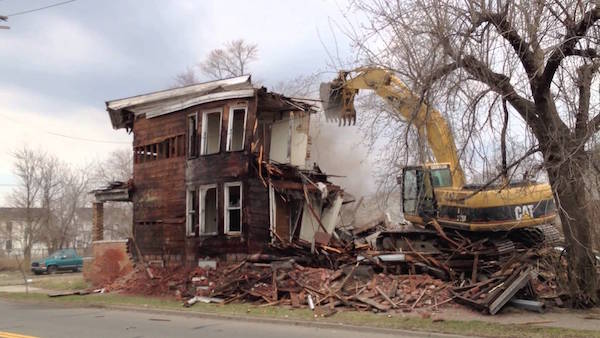
It is great that we can supply reclaimed materials to the general public, but it is somewhat perplexing however, that there is still so little consideration given to the demolition process, and the energy involved in each aspect, that has to happen in order for us to do so!
Embodied energy is the prickly catch phrase that sends us all into turmoil from time to time, as conscientious builder types. Reclaimed vs new, sustainably harvested, sensible design (a given), thermal mass, low-e etc etc… the beginning of a build comes with so many considerations and deliberations, each as valid as the other. Combined, they will determine the longevity of the dwelling (and how you feel in it), which should really justify the energy of the build in the first place!
The practice of demolishing a perfectly sound house, especially in areas of high land value, has risen exponentially in the past 15 years, as subdivisions make way for higher density housing, a sensible practice in itself perhaps, but what of demolished buildings?
Developers themselves, have a small budget for the demolition process, which will involve paying a ‘demolisher’ to do the ‘job’ to make way for the new… understandable, but what is the demolisher’s process?
In the past, when demolition was approached in a more ‘considered’ manner (ie, dismantled by hand) and especially during lean times, demolishers squirreled items of ‘interest’ away [must read – Robyn Annear’s ‘A City Lost and Found’… history of Whelan the Wrecker], to the delight of the general public, where historical treasures could be discovered for the taking!
Obviously, the 21st century is a different world for those working in demolition… the Worksafe laws (for good reason) make it very difficult for anybody to have access to a demolition site, with exception of the excavator driver, ripping it all down.
Needless to say, anything worth saving (normally up to 90% of any structure) is damaged beyond salvage, and only good for landfill.
A good recent example is the ‘education sector of the economic stimulus package’ that was implemented under a recent government.
Although it shouldn’t be denied that it was time schools across the nation were rejuvenated (to say the least), from our perspective, the government looked forward without a second glance over their shoulder, like any developer with a job to do.
We witnessed (and are still) state of the art buildings going up on the block next door to their aged counterpart, which was being bulldozed as quickly as they could get the machines onto site. There was no time for the only 2 existing house stripping teams in Victoria to salvage everything possible… there was only occasionally the opportunity to have a week unbolting what was feasible within the time frame.
This burst of nation wide construction alone has contributed to untold amounts of landfill… with extremely useful building materials.
We all know that the building industry is a heavy contributor to landfill, demolishers and DIY’ers are feeling the pinch when it comes of disposing building waste at the tip… and the rise of illegal dumping demonstrates this fact.
We all know the role of demolishers, and the impact of landfill… but mention the term ‘house strippers’ and most people will look at you with mock bemusement and curiosity.
The undervalued and absolutely vital role of house strippers is a dying industry in Australia that could, with the right acknowledgement and support, be the answer to many of our landfill issues affected by the domestic housing industry, integral to the survival of the salvage industry, and also to future of the planet… in the big picture!
House stripping is the crucial part prior to the demolition process that determines the amount of landfill that is created by that process.
Today there are only 2 small crews of strippers operating in Victoria… and yet the rising cost of landfill means that demolishers are now lining up for their services.
We are passionate about actively working to boost the profile of necessary salvage of building waste in Australia, through our salvage yard in Castlemaine.
We understand too well, the environmental impact of the building industry… and the enormous waste into landfill, of materials that are better quality today than the day they made the journey from raw material to structural timber.
We are entirely dependent on the dwindling number of house strippers remaining in Victoria to supply our needs and the needs of the growing numbers of ethically minded home builders, owner builders and conscious builders’ who have made the sensible choice to use these materials in their own projects.
We hope that by boosting the profile of salvage, as a community, we can further lobby the lawmakers to recognise the importance of re evaluating the zero tolerance stance on salvaging from building demolition sites… and in turn perhaps supporting the little known industry that is the ‘house stripper’.
We believe that the role of the house stripper should be recognised at a similar level to that of other trades. This is the only way that an industry can be sustained, on a viable and safe level. Until this happens, salvage will remain a tenuous affair.



